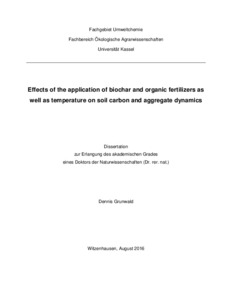| dc.date.accessioned | 2017-11-27T08:39:37Z | |
| dc.date.available | 2017-11-27T08:39:37Z | |
| dc.date.issued | 2017-11-27 | |
| dc.identifier.uri | urn:nbn:de:hebis:34-2017112753878 | |
| dc.identifier.uri | http://hdl.handle.net/123456789/2017112753878 | |
| dc.description.sponsorship | Diese Arbeit wurde von der Deutschen Forschungsgemeinschaft im Rahmen des DFG-Graduiertenkollegs 1397 "Steuerung von Humus- und Nährstoffhaushalt in der ökologischen Landwirtschaft" gefördert. | ger |
| dc.language.iso | eng | |
| dc.rights | Urheberrechtlich geschützt | |
| dc.rights.uri | https://rightsstatements.org/page/InC/1.0/ | |
| dc.subject | Bodenkunde | ger |
| dc.subject | Pflanzenkohle | ger |
| dc.subject | Kohlenstoff | ger |
| dc.subject.ddc | 550 | |
| dc.title | Effects of the application of biochar and organic fertilizers as well as temperature on soil carbon and aggregate dynamics | eng |
| dc.type | Dissertation | |
| dcterms.abstract | Soil aggregate formation is an important process for long-term carbon storage in soils. While it has been shown that plant residues exert a positive influence on aggregate formation, the effects of organic fertilizers such as cattle slurry or manure as well as the effects of biochar application to soil are less clear. Furthermore, little is known about the role of increased soil temperatures in aggregate dynamics.
The main objectives of this thesis were to analyse the effects of (i) cattle slurry and manure, (ii) the application of biochar and (iii) different temperature regimes on soil aggregate and carbon dynamics. For this, two incubation experiments and one field trial were analysed. In the laboratory experiments soil without macro-aggregates was incubated at different temperatures with biochar, slurry, manure or different mixtures of biochar and slurry. In the sampled field trial the factors increased soil temperatures and biochar application were analysed.
The results show no or negative effects of biochar application on soil aggregate formation, while slurry was found to have positive effects. The combined application of biochar and slurry led to lower aggregate yields than the solitary application of slurry. However, interactions between biochar and mineral soil particles were already found shortly after the application in both the incubations and in the field trial, leading to an increase of aggregate-occluded and thus protected soil organic carbon, especially in combination with a slurry application. Increased temperatures in steps of 10 °C led to an increased aggregate formation in the incubation experiments, presumably due to a metabolization of aggregate binding agents. In the field, however, a temperature increase of 2.5 °C did not show any effects on soil aggregate or carbon dynamics. | eng |
| dcterms.accessRights | open access | |
| dcterms.creator | Grunwald, Dennis | |
| dc.contributor.corporatename | Kassel, Universität Kassel, Fachbereich Ökologische Agrarwissenschaften | |
| dc.contributor.referee | Ludwig, Bernard (Prof. Dr.) | |
| dc.contributor.referee | Potthoff, Martin (Dr.) | |
| dc.contributor.referee | Jörgensen, Rainer Georg (Prof. Dr.) | |
| dc.contributor.referee | Peth, Stephan (Prof. Dr.) | |
| dc.subject.swd | Bodenkunde | ger |
| dc.subject.swd | Pflanzenkohle | ger |
| dc.subject.swd | Kohlenstoff | ger |
| dc.date.examination | 2017-02-02 | |

